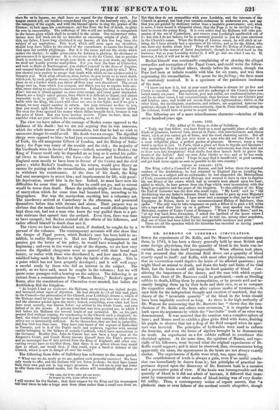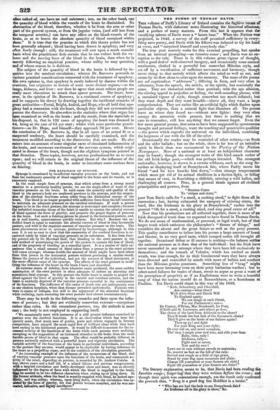DR. BURROWS ON CEREBRAL CIRCULATION.
SINCE the experiments of Dr. Kellie, and Dr. Monro's observations upon them, in 1783, it has been a theory generally held by most British and some foreign physicians, that the quantity of blood in the brain was in- variable, and the brain itself incompressible. When effusion took place, it was assumed that the abnormal fluid drove out a quantity of blood exactly equal to itself: and Kellie, with most other physicians, conceived that no venesection could deprive the brain of its allotted quantum ; you might bleed an animal to death, and drain the body and limbs of its vital fluid, but the brain would still keep its fixed quantity of blood. Con- sidering the importance of the theory, and the ease with which experi- ments like those of Dr. Burrows could be performed,--such as bleeding rabbits to death, killing them by strangulation, or by prussic acid and in- stantly hanging them up by their heels and their ears, so as to compare the respective states of the brain after various modes of treatment,—it says little for the independent thought and exertion of mankind, that the theory of the "invariable quantity" of the blood in the brain should have been implicitly received so long. As there is the high authority of Dr. Watson for announcing that Dr. Burrows has "shown that the con- clusions of Dr. Kellie and others were erroneous," it is singular to look back upon the arguments by which the "inevitable" truth of an error was demonstrated. It was asserted that the cranium was a complete sphere of bone ; and Munro used to exhibit a glass globe filled with water, desiring his pupils to observe that not a drop of the fluid escaped when its aper- ture was inverted. The principles of hydraulics were used to enforce the doctrine, and even the forms of algebra brought in to demonstrate its truth. An experiment on a few rabbits sufficed to overthrow this cherished opinion. At the same time, the opinions of Munro, and espe- cially of his followers, went beyond what the original experiments of Dr. Kellie would support; and it must be observed, that, circumstances being apparently the same, the appearances in the brain are not always exactly similar. The experiments of Kellie were tried, too, upon sheep.
The establishment of truth is always a gain, even if no useful conclu- sion can immediately be drawn from it ; but principles of practical im- portance depend upon the discovery of Dr. Burrows both in a curative and a preventive point of view. If the brain was incompressible and the quantity of blood in it did not admit of increase, it followed that treat- ment by venesection or other modes of blood-letting was of very doubt- ful utility. Thus, a contemporary writer of, repute asserts, that "a plethoric state or over fulness of the cerebral vessels altogether, though
often talked c4 can have no real existence; nor, on the other hand, can the quantity of blood within the vessels of the brain be diminished. No abstraction of the blood, therefore, whether it be from the arm or other part of the general system, or from the jugular veins, (and still leas from the temporal arteries,) can have any effect on the blood-vessels of the brain, so as to lessen the absolute quantity of blood contained within them." It is true that the practice to which this theory points has not been generally adopted ; blood having been drawn in apoplexy, and very often freely enough : still, the treatment will rest upon a much sounder basis when the practitioner feels certain that he can reduce both the vo - Iume and the moving force of the blood in the brain, than when he is merely following an empirical practice, whose utility he may question, and of whose reason he is dubious.
The subject of the quantity of blood in the brain is followed by in- quiries into the cerebral circulation; whence Dr. Burrows proceeds to various practical considerations connected with the treatment of apoplexy. Uia own opinion is, that apoplexy is rarely induced by disease within the cranium, but originates in lesions of some more distant organs,—as the lens, kidneys, and liver : nor does he agree that stout robust people are really more obnoxious to attack than sparer persons. The heart, how- ever, in the opinion of Dr. Burrows, is a continual source of apoplexy ; and he supports his theory by drawing together the incidental remarks of great authorities—Portal, Bright, Andral, and Hope, who all held that apo- plexy had a connexion with the heart, though they did not systematically pursue the discovery. He also refers to the statistics where that organ has been examined as well as the brain : and the result, from the materials at his disposal, is, that in 132 cases of apoplexy the heart was diseased in 84, being at the rate of 63 per cent ; whilst with some particular practi- tioners—as Dr. Hope, and himself—they approach 70 per cent. Hence the conclusion of Dr. Burrows is, that in all cases of an actual fit or a suspected tendency, the heart should be carefully examined, and the treatment modified according to the discoveries that are made. He also enters into an account of some singular cases of simulated inflammation of the brain, and enormous excitement of the nervous system, which origi- nated in disease of the heart, though not the slightest symptom pointed in that direction. These topics, however, are too professional for us to enter upon ; and we will return to the original theme of the influence of the quantity of blood in the brain, in order to introduce some curious facts on fainting.
THE RATIONALE OF SYNCOPE.
Syncope is occasioned by insufficient vascular pressure on the brain, and not from the inadequate quantity of blood supplied to the brain and its vessels, as is commonly supposed. In the most simple form of syncope, that which arises from a strong moral emotion in a previously healthy person, we see the single effect of want of due vascular pressure on the brain. In such cases the quantity and quality of the blood in the person's body are unaltered previous to the syncope, and the saspen- aim of the cerebral functions arises solely from the diminished energy of the heart. The blood is no longer propelled with sufficient force from the left ventricle to maintain an adequate pressure on the cerebral substance. If such a person happen to be in the erect posture, the syncope is more rapid and complete; because the enfeebled muscular tissue of the heart is unable to sustain the arterial current Or blood against the force of gravity, and preserve the proper degree of pressure on the brain. Let such a fainting person be placed in the horizontal posture, and, as is well known, consciousness quickly returns. But why? Because the en- feebled heart is equal to maintain the arterial current of blood in that favourable posture, and with it the requisite amount of vascular pressure on the brain. The same phienomena occur in syncope, produced by hmmorrhage, although in this case it is not so easy to show that the suspension of the cerebral functions is oc- casioned solely by want of vascular pressure on its substance. It has been forci- bly pointed out by Dr. Marshall Hall, that bleeding in the erect posture is the best method of ascertaining the power of the system to sustain the loss of blood, and of the propriety of bleeding as a remedial agent. It is a matter of daily ex- perience that a small amount of blood taken from a person in the erect posture will cause syncope; whereas double the amount of blood might have been taken from that person in the horizontal posture without producing a similar result. Hence the posture of the individual, and not the amount of blood abstracted, is the more efficient cause of the syncope. The effects of the erect posture in modi- fying the influence of the heart on the brain I have just described.. In extreme states of debility, from whatever cause produced, the mere sudden assumption of the erect posture is often adequate to induce an alarming and sometimes fatal syncope. In this posture the feeble heart is unable to project the blood against the force of gravity in the carotid and vertebral arteries, and the brain is suddenly deprived of the vascular pressure essential to the continuance of its functions. The influence of this cause of death was not unfrequently seen in our cholera hospitals, when that disease prevailed epidemically. Patients who were in states of collapse, but still in the enjoyment of the sensorial functions while reclining, upon assuming the erect posture died almost instantaneously.
There may be truth in the following remarks and facts upon the influ- ence of posture; but they are evidently somewhat extreme—exceptions rather than rules. In the recumbent posture, too, the attitude is more easy; the body is not employed in supporting itsel£
"We occasionally meet with instances of a still greater influence exercised by posture over the cerebral functions. It is an observation which has been fre- quently made, that many men of genius, poets and others engaged in literary composition, have enjoyed the most rapid flow of brilliant ideas while they have been resting in the horizontal posture. It. would be difficult to account for them-
creased activity of the functions of the brain while such persons were reclining,
excepting on the supposition of an increased stimulus to the brain from the more forcible access of blood to that organ. The effect would be probably different in persons naturally endowed with a powerful heart and vigorous circulation. The variable activity of the functions of the brain in particular individuals, according to the posture they assume, would appear to be explicable by having reference to the heart as a propelling organ and to the condition of the circulation generally. "An interesting example of 'the influence of the momentum of the blood, and of varying vascular pressure upon the functions of the brain, and consequent ac- tivity of the mind, depending on posture1. is recorded by Dr. Andrew Combo. A bey, eleven years and a half old, of a mixed bilious and nervous temperament, with a languid circulation and feebly-developed chest and heart, was so directly influenced by the degree of force with which the blood is supplied to the brain, that he seemed to be two different characters when sittieg up or lying down. In the former attitude, when the head is scantily supplied with blood, he looked ape- ffietic, and was sullen; whereas, upon lying down when the circulation was as- sisted by the force of gravity, his real Jewess became manifest, and he was am- mated, talkative, and highly intelligent.











































 Previous page
Previous page